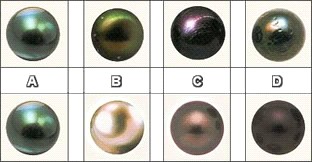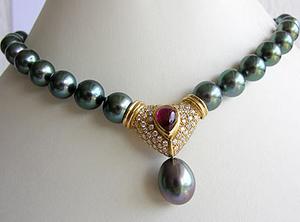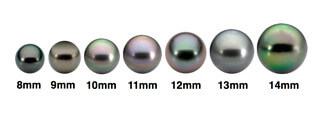Black Tahitian Pearl Basics
In just the 30 years they've been in the jewelry marketplace, the Tahitian cultured pearl has made its mark. These big, colorful gems are prized for their large size and exotic naturally dark colors.
Not Only Black Pearls
You'll often hear these gems referred to as "Tahitian Black Pearls." The name has caused a couple of misconceptions about the pearls.
First, Tahitian cultured pearls aren't only black. They appear in shades of brown, gray, blue, green and purple as well. They also have gorgeous overtones that give Tahitian cultured pearls an incredible beauty all their own.
Secondly, the gems aren't found in Tahiti. Tahiti is the largest island in French Polynesia, but the pearl culturing farms are found on other islands in the territory, which is located in the South Pacific.
The pearls are found in a bivalve mollusk called the black-lipped oyster that is native to French Polynesia. The inside edges and edges of the mantle are rainbow colored. It is found from the Persian Gulf to the Gulf of California.
In nature, the black-lipped oyster can live up to 30 years, grows up to a foot in diameter and weighs up to 1 pound. During the years it produces pearls, ages 3 to 7, the black-lipped oyster is usually between 6 and 8 inches in diameter.
Island Paradise
The five archipelagos that make up French Polynesia lie East of Australia. They are the Marquesas Islands, Gambier Islands, Austral Islands, the Tuamotu Archipelago and the Society Islands, which contain Tahiti. The islands are spread out over an area the size of Europe, but their land surface is only 1,500 square miles.
The lagoons of the Tuamotu Archipelago and Gambier Islands are home to most of the pearl farms that cultivate Tahitian pearls. Many of the islands are very remote and only accessible by seaplane or boat. Each farm is self-sufficient, with solar energy, vegetable gardens and poultry. The water around these islands is very clean, which helps in the culturing process.
The shallow lagoons of these islands are surrounded by rings of land and coral reefs. The waters are nutrient rich and relatively calm.
Tahitian Pearl Grading The A - D System (or Tahitian System)
The A - D System (or Tahitian System)This system grades pearls on a scale from A to D, with A being the highest grade. This is the system used in French Polynesia (based on a government standard there) to grade Tahitian pearls. It is therefore sometimes referred to as the "Tahitian system." To make your shopping experience easier at PearlsOfJoy.com we utilize the AAA-A system for all of our pearls. Below is an explanation of the tahitian system and how it relates to the grading used at PearlsOfJoy.com
Tahitian Pearl Value Factors
Tahitian cultured pearls are often high value on the pearl market. They're bigger than most pearls, are comprised of unusual colors and take more time to produce. Value is also tied to their demand - there are fewer Tahitian pearls produced than Akoyas
An unusually large, extremely high-quality Tahitian cultured pearl can cost thousands of dollars. A bargain when you consider that a graduated strand of 10 mm to 14 mm Tahitian pearls can fetch $30.000 to $40,000 from a retail jeweler! One triple-strand jewelry piece ranging from 12 mm to 15 mm was sold in the late 1980s for $880,000!
Size and Shape
One of the strongest value factors of Tahitian cultured pearls is their size. Most range between 8 mm and 14 mm. Rarely pearls grow into the 16 mm to 18 mm range. In the late 1990s, one specimen was recorded just shy of 27 mm.
Less than 50 percent of any Tahitian cultured pearl crop is actually round, so spherical gems have a much higher value. Tahitian cultured pearls also are more likely to have circles -grooves or rings all the way around them. Although circled pearls have less value, some designers and jewelry lovers value them for their uniqueness.
Color And Luster
Color is one of the Tahitian cultured pearl's strongest value factors. The Tahitian trade generally recognizes three color groups. Tahitian pearl farmers experiment with several factors to produce different cultured pearl colors. Every black-lipped oyster produces a different colored pearl. Organic compounds in the shell are speculated to create the color variation. Many pearl farmers will say that the mantle from a donor oyster used in the culturing process, determines the color about 80 percent of the time. The pearl's nacre quality can affect its color as well. Others attribute environmental factors to determining pearl color - like the amount of salt in the water or the quality and quantity of food available to the oysters.
Tahitian pearls have great luster. So great is the luster in most of the pearls that all they take is a little buffing once they are taken from the oyster. Luster generally ranges from fair to excellent. Often the luster produces a metallic sheen and an overtone.
Surface Quality
Most Tahitian cultured pearls have a few blemishes, however they can range from spotless to heavily spotted. Most are heavily blemished in one area, which is hidden by the setting or a drill hole.
Most Tahitian cultured pearls have acceptable nacre. Rarely do you find these pearls with visible nuclei or a chalky appearance. In the years the pearl is allowed to cultivate, Tahitian cultured pearls often grow 2 mm of nacre all the way around the bead nucleus.
For Tahitian pearls, the government of French Polynesia has set a minimum nacre thickness of 0.8 millimeters. Any pearls with nacre of less than that thickness are not allowed to be sold. Keeping in mind that Tahitian pearls tend to be larger than many other pearls (such as Akoyas), you can use this rule as a guideline when evaluating your own potential pearl purchases.
Article Source:
http://www.pearlsofjoy.com/Image Sources:
http://www.nationalpearl.com/http://www.pearlsofjoy.com/http://www.destination360.com/http://www.cliclasp.com/http://media.marketwire.com/http://www.tahiapearls.com/http://mallofstyle.com/